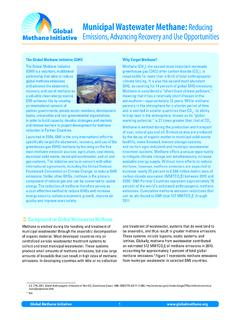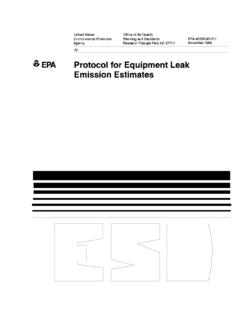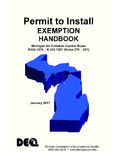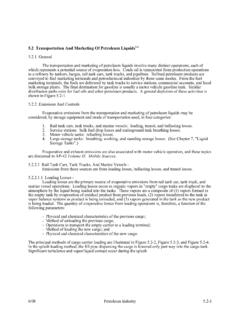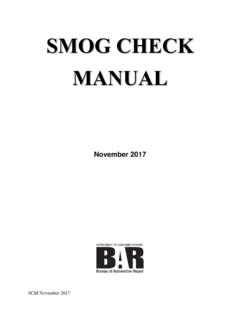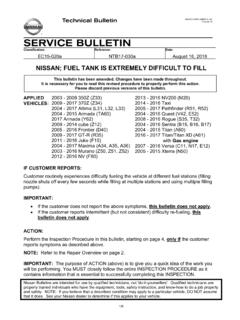Transcription of Global Methane Emissions and Mitigation Opportunities
1 Global Methane Emissions by SectorGlobal anthropogenic Methane Emissions by 2020 are estimated to be 9,390 million metric tons of CO2 equivalent (MMTCO2E).2 Approximately 54 percent of these Emissions will come from the five sources targeted by the Global Methane Initiative (GMI): agriculture (manure management), coal mines, MSW, oil and natural gas systems, and wastewater (see Figure 1).GMI Partner Countries (see for complete list) represent approximately 70 percent of the world s estimated anthropogenic Methane Emissions . Partner countries major Methane emission sources vary greatly, and thus the Opportunities for Methane capture and use in each country also vary. Global Emissions ProjectionsGlobal anthropogenic Methane Emissions are projected to increase by nearly 9 percent over anticipated 2020 levels to 10,220 MMTCO2E by 2030 (see Figure 2). From 2020 to 2030, the relative proportions of the agriculture (manure management), coal mines, and wastewater sectors are projected to Why Target Methane ?
2 Methane is the second most abundant anthropogenic greenhouse gas (GHG) after carbon dioxide (CO2), accounting for about 20 percent of Global Emissions . Methane is considered a short-term climate forcer, meaning it has a relatively short lifespan in the atmosphere of approximately 12 years. Though Methane is in the atmosphere for a shorter period of time and is emitted in smaller quantities than CO2, its Global warming potential ( , the ability of the gas to trap heat in the atmosphere) is 28-34 times As a result, Methane Emissions contributed to about one-third of today s anthropogenic GHG is emitted during the production and transport of coal, natural gas, and oil. Emissions also result from the decay of organic matter in municipal solid waste (MSW) landfills, some livestock manure storage systems, and certain agro-industrial and municipal wastewater treatment systems. Capturing Methane from these sources offers a unique opportunity to mitigate climate change and simultaneously increase energy security, enhance economic growth, and improve air quality and worker safety.
3 Global Methane Initiative 1 Methane Emissions and Mitigation OpportunitiesFigure 1: Estimated Global AnthropogenicMethane Emissions by Source, 2020 Rice Cultivation 7%Biomass 3%Stationary &Mobile Sources 4%Coal Mining 9%Municipal SolidWaste 11%Oil & Gas 24%Wastewater 7%Agriculture (ManureManagement) 3%Enteric Fermentation 27%Other Ag Sources 5%CoalMiningEnteric FermentationRiceCultivationFigure 2: Estimated and Projected Global AnthropogenicMethane Emissions by Source, 2020 and 2030-500050010001500200025003000 MunicipalSolidWasteOil andGasWastewaterManureManagementStationa ry& MobileOther AgSourcesBiomassEstimated 2020 EmissionsProjected Added Emissions by 20301 The fifth report of the Intergovernmental Panel on Climate Change (IPCC), released in 2013, included Methane GWP values of 28 to 34. The United States and other de-veloped countries are currently using the fourth report s GWP value of 25 to quantify the climate impact of Methane reduction Unless otherwise noted, all data are from Environmental Protection Agency s ( EPA s) Global Anthropogenic Emissions of Non-CO2 Greenhouse Gases: 1990 2030 report.
4 Methane Initiative 2 constant, while Emissions from MSW and the oil and gas sectors are expected to increase by approximately one percent of estimated Global anthropogenic Methane Emissions (see Figure 3). Within each sector, Methane Emissions from agriculture, MSW, and wastewater treatment systems are expected to increase by 5, 6, and 8 percent respectively. Oil and gas Emissions are estimated to increase by 11 percent over current levels. Finally, Emissions associated with coal mines are expected to increase by 17 percent from 2020 to 2030. Benefits of Methane MitigationCost-effective Mitigation technologies and practices to address Methane Emissions from the largest anthropogenic sources are already widely available and in use all over the In addition to mitigating climate change, reducing Methane Emissions delivers a host of other energy, health and safety, and local environmental benefits. Many technologies and practices that reduce Methane Emissions also reduce Emissions of volatile organic compounds, hazardous air pollutants, and other local air pollutants.
5 This yields health benefits for local populations and workers. Because Methane is an important precursor of tropospheric ozone, reducing Methane also reduces ozone-related health reduction projects at landfills and wastewater treatment plants also reduce odors; in the agriculture sector, they control manure, protect local ecosystems, and reduce odors. Capturing Methane from gassy coal mines improves industrial safety by reducing the risk of explosions. The use of low- emission equipment and better management practices in oil and natural gas systems minimizes Methane leaks, yielding health and safety benefits while increasing efficiency, thus generating increased any project, recovering Methane provides a local source of clean energy that can spur economic development and displace higher CO2- and pollutant-intensive energy sources such as wood, coal, and oil. Recovered Methane can also serve as a new sustainable and abundant energy source for developing countries.
6 Overview of Mitigation Opportunities Many of the currently available Methane Mitigation Opportunities involve the recovery and use of Methane as fuel for electricity generation, onsite uses, or offsite gas sales. Specific technologies and Mitigation approaches, however, vary by emission source because of their different characteristics and emission processes. The matrix (on page 3) provides a brief summary of the Mitigation Opportunities by sector, as well as examples of Mitigation technologies from Partner Countries. The Global Methane InitiativeThe Global Methane Initiative (GMI) is a voluntary, multilateral partnership that aims to reduce Global Methane Emissions and to advance the abatement, recovery, and use of Methane as a clean energy source. GMI achieves this goal by creating an international network of partner governments, private sector members, development banks, universities and non-governmental organizations to conduct assessments, build capacity, create partnerships, and share information to facilitate project development for Methane reduction in GMI Partner than 1,000 public and private sector organizations are members of the GMI Project Network, and have helped the program to leverage nearly $600 million in investment from private companies and financial 3.
7 Global Anthropogenic Methane Emissions , 1990 - 2030 MMTCO2E200020202030 AgricultureCoal MinesMunicipal Solid WasteOil & GasWastewater01000200030004000500060003 The Fourth Assessment Report of Working Group III of the IPCC ( ) and the EPA report, Global Mitigation of Non-CO2 Greenhouse Gases ( ), both contain information on Methane Mitigation Methane Initiative 3 of MethaneGlobal Methane Emissions per Sector* Mitigation OpportunitiesProven Mitigation TechnologiesAgriculture (Manure Management)Produced from decomposi-tion of livestock and poultry manure stored or treated in systems that promote anaerobic conditions ( , liquid or slurry in lagoons, ponds, tanks, or pits). 286 MMTCO2E Covered anaerobic lagoons collect and transmit lagoon-generated biogas to a dedicated point for transmission to some type of gas use device ( , engine). Digesters ( , plug flow, complete mix) that compost or digest organic waste in the absence of oxygen, thereby generating Methane for collection and more information from the Agriculture Subcommittee: Dome Anaerobic Digester (India)Coal Mines Emitted from active and abandoned underground mines and surface mines, and as a result of post-mining activities including coal processing, storage, and MMTCO2E Degasification, where holes are drilled and the Methane is captured (not vented) in conjunction with mining operations.
8 Ventilation air Methane (VAM) abatement, where low concentrations of Methane are oxidized to generate heat for process use and/or electricity more information from the Coal Subcommittee: Pump Station (Ukraine)Municipal Solid Waste Produced through the decomposition of organic waste under anaerobic conditions typically found in landfills and large dump sites. 1,077 MMTCO2E Extraction using a series of wells and a vacuum system, which directs the collected gas to a point to be combusted in a flare or utilized for energy ( , electricity generation, boiler, dryers, vehicle fuel).For more information from the Municipal Solid Waste Subcommittee: Gas Well (China)Oil & Gas SystemsEmitted during normal operations, routine main-tenance, and system disrup-tions in the oil and natural gas industry. 2,276 MMTCO2E Technologies or equipment upgrades that reduce or eliminate equipment venting or fugitive Emissions .
9 Enhanced management practices that take advan-tage of improved measurement or emission reduc-tion technology. For more information from the Oil and Gas Subcommittee: Detection equipment (Mexico)WastewaterProduced by decay of organic material in waste-water as it decomposes in anaerobic MMTCO2 EInstallation of: Anaerobic sludge digestion (new construction or retrofit of existing aerobic treatment systems). Biogas capture systems at existing open air anaerobic lagoons. New centralized aerobic treatment facilities or cov-ered lagoons. Gas capture and combustion systems to flare or utilize Methane ( , onsite electricity or other thermal uses).For more information from the Wastewater Subcommittee: Wastewater Treatment (Chile)*estimated annual 2020 emissionsGlobal Methane Initiative 4 Emission Reduction Potential by SectorMethane Emissions can be relatively inexpensive to reduce compared with CO2, and various government agencies and organizations are incorporating non-CO2 Mitigation into analysis and policy discussions.
10 EPA s Global Mitigation of Non-CO2 Greenhouse Gas report conducted an analysis applying currently available Mitigation options and technologies to Global Methane emission baselines in the five GMI target sectors to provide insight into Methane emission reduction potential and costs. 4 Agriculture (Manure Management): Has an increasing reduction potential of 3 to 10 percent associated with raising activity costs from $15 to $30/MTCO2E. Increasing costs to $60 generates an additional 5 percent abatement but at diminishing margins of return per cost increase. The Global abatement potential or GAP (at any cost) is only 28 percent of the baseline. Coal Mines: 56 percent of potential reductions which represents nearly all of the sector s GAP could be achieved by increasing costs from $0 to $15/MTCO2E, above which the potential for reductions remains steady regardless of increased activity cost. MSW: Has an emission reduction potential of more than 25 percent with a minimal $15/MTCO2E investment, but remains relatively constant per cost increment from $30 to $60/MTCO2E.

